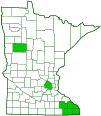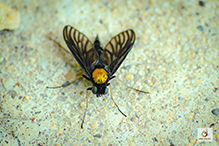golden-backed snipe fly
(Chrysopilus thoracicus)
Conservation • Description • Habitat • Ecology • Distribution • Taxonomy
|
|
||||||||||||||
Description |
Golden-backed snipe fly is medium-sized fly. It occurs in the United States from New Hampshire to North Carolina west to Minnesota and Oklahoma, and in southern Ontario Canada. It is common in the east, uncommon in Minnesota. It is found in deciduous woodlands. Larvae are found in water (aquatic) or in moist, organic-rich soil. They prey on earthworms, soft-bodied insects, or grasshopper eggs. Adults prey on other insects but it is thought that they feed little. Adults are black with highly contrasting white and gold markings. Females are ⅜″ to ½″ (10 to 13 mm) long, males slightly smaller, ⅜″ to ½″ (10 to 12 mm) long. The head is black and more or less rounded. There are two large compound eyes on the side of the head and three small simple eyes (ocelli) in a triangle on top of the head. The back of the head is densely covered with long black hairs. On the male the compound eyes are very large and meet at the top of the head. On the female the compound eyes are smaller and widely separated. The antennae have three segments. The third segment is cone shaped, is not divided by rings (annulated), and bears a long, slender style (arista) at the end. The arista is distinctly longer than the antenna. The thorax has three segments. The upper side is densely covered with short golden hairs. This is the feature that gives the fly its common name. The genus name Chrysopilus translates to “gold hair”. The sides of the third segment (metapleura) are densely covered with black hairs. The abdomen on the male is narrow and tapered. On the female it is broad and is tapered at least on the lower half. Each abdominal segment is black and has a dense band of silvery-white or pale yellow hairs at the end (apex) except for an interruption in the middle. The wings appear dark but are mostly clear with prominent black veins. There is a broad, smoky brown border along the leading edge (costal margin). The veins usually have broad borders tinged dark smoky brown. The anal cell is longer than the second basal cell and is closed before the wing margin. The legs are relatively long and mostly pale. On the front legs the fourth segment does not have spurs at the end. On the hind legs there is just one spur at the end of the tibia. |
Size |
Male: ⅜″ to ½″ (10 to 12 mm) long Female: ⅜″ to ½″ (10 to 13 mm) long |
Similar Species |
Habitat |
Deciduous woodlands |
Ecology |
Season |
Early to mid-spring |
Behavior |
Adults perch on low vegetation. |
Life Cycle |
Little is known about the life cycle. |
Larva Food |
Earthworms, soft-bodied insects, or grasshopper eggs |
Adult Food |
Insects |
Distribution |
||
|
Sources |
|
| 6/15/2024 | ||
Occurrence |
||
Uncommon in Minnesota |
||
Taxonomy |
|
Order |
|
Suborder |
Brachycera |
Infraorder |
Orthorrhapha |
Parvorder |
Tabanomorpha (snipe flies and allies) |
Superfamily |
Rhagionoidea |
Family |
Rhagionidae (snipe flies) |
Subfamily |
Chrysopilinae |
Genus |
Chrysopilus |
Subfamily |
|
Subordinate Taxa |
|
|
|
Synonyms |
|
Leptis thoracicus |
|
Common Names |
|
golden-backed snipe fly |
|
Glossary
Arista
A large bristle on the upper side of the third segment of the antenna of a fly. Plural: aristae.
Costal margin
The leading edge of the forewing of insects.
Ocellus
Simple eye; an eye with a single lens. Plural: ocelli
Tibia
The fourth segment of an insect leg, after the femur and before the tarsus (foot). The fifth segment of a spider leg or palp. Plural: tibiae.
Visitor Photos |
||
Share your photo of this insect. |
||
This button not working for you? |
||
Saving Our Sanctuaries |
||
 |
 |
|
Alfredo Colon |
 |
Mike Poeppe |
||
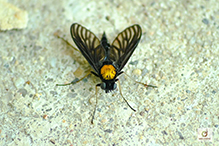 |
||
Babette Kis |
||
Chrysopilus thoracicus (golden-backed snipe fly) I've attached a few of my favorite photos of these easily recognizable snipe flies. Spring is the time to find these colorful flies in nature preserves, prairies, woodland edges and suburban gardens. They're often in partly shaded areas. |
||
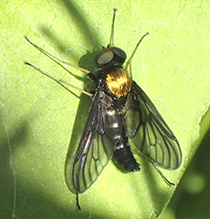 |
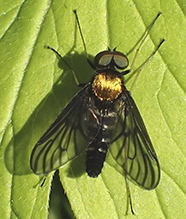 |
|
Golden-backed snipe fly, Barnes Prairie hedgerow, Racine Co, WI May 29 2021 |
golden-backed snipe fly at Hedgerow next to Barnes Prairie on Mayapple, Racine Co., Wisconsin May 29, 2021 |
|
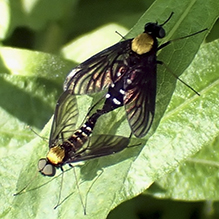 |
||
Golden-backed snipeflies m f Barnes Prairie hedgerow Racine Co., WI June 1 2020 |
|
|
Greg Watson |
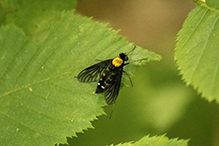 |
I noticed that you don’t have a golden-backed snipe fly picture. Well, now you will with the picture that I took. |
MinnesotaSeasons.com Photos |
||
 |

Slideshows |
|

Visitor Videos |
||
Share your video of this insect. |
||
This button not working for you? |
||
|
Other Videos |
||
Gold-Backed Snipe Fly resting on grass |
About
Jun 30, 2019 Gold-Backed Snipe Fly resting on grass | Insect | Pattern, Habits, Habitat, Facts, Information, Documentary, Identification, Behavior | brilliant gold hair positioned on the upper thorax | Chrysopilus thoracicus | Diptera, dípteros, Zweiflügler, diptères, Ditteri | Rhagionidae, Schnepfenfliegen | HD video | Wildlife, Animal Behavior, Nature | #GoTrails, #insect, #insects, #arthropod, #snipefly |

Visitor Sightings |
||
Report a sighting of this insect. |
||
This button not working for you? |
||
Saving Our Sanctuaries |
Location: West of La Crescent, MN |
 |
Alfredo Colon |
Location: Albany, NY |
 |
Mike Poeppe |
Location: a mile West of Houston, MN. |
 |
| Babette Kis 5/29/2021 |
Location: Barnes Prairie, Racine Co., WI golden-backed snipe fly at Hedgerow next to Barnes Prairie on Mayapple, Racine Co., Wisconsin May 29, 2021 |
 |
| Babette Kis 6/1/2020 |
Location: Barnes Prairie, Racine Co., WI Golden-backed snipeflies m f Barnes Prairie hedgerow Racine Co., WI June 1 2020.JPG |
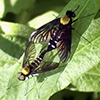 |
MinnesotaSeasons.com Sightings |
||
|

Created: 7/6/2021 Last Updated: © MinnesotaSeasons.com. All rights reserved. |
